Francis Kéré becomes first African architect of Serpentine pavilion
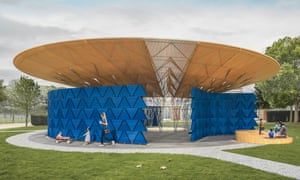 |
| Serpentine Pavilion by Francis Kéré |
The architect is planning to bring one of his characteristically
stripped-back structures, honed in the villages of his native Burkino
Faso, to leafy west London.
Author | Oliver Wainwright
Source: The Guardian Newspaper
Author | Oliver Wainwright
Source: The Guardian Newspaper
A huge wooden disc will float above the lawn in Kensington Gardens this summer, a wheel of spindly timber slats hovering over a bright blue landing pad like some rustic flying saucer. This is the vision of Diébédo Francis Kéré, the first African architect to be chosen to design the annual Serpentine gallery pavilion, who plans to bring one of his characteristically stripped-back structures, honed in the villages of his native Burkina Faso, to leafy west London.
“The tree was always the most important place in my village,” he says, describing the inspiration for his design. “It is where people come together under the shade of its branches to discuss, a place to decide matters, about love, about life. I want the pavilion to serve the same function: a simple open shelter to create a sense of freedom and community.”
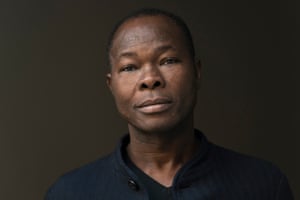
Photograph: Erik-Jan Ouwerkerk
While the scorching sun might be the thing to shelter from in the deserts of west Africa, Kéré has configured his London canopy more with rain in mind, designing the shallow saucer to funnel water into a central opening, where a ring of slender steel trusses will support the great wooden bowl. The space will be loosely enclosed by a series of curving blue walls, formed of staggered wooden blocks in a textile-like pattern, a reference to the festive clothing worn by young men in his village on special occasions. “I’m coming to London,” he says, “so I wanted to show myself with my best clothes.”
In its frugal simplicity, the pavilion is a departure from recent years’ structures that have revelled in their sculptural novelty or shouted for attention with bright colours and synthetic materials. It is an apt reflection of Kéré’s work in Africa, where he has established an international reputation for designing sparing structures with mud bricks and lightweight steel frames, often built by unskilled labour with an elegant economy of means. Kéré initially considered using bricks for the pavilion walls, but was clearly advised against turning the royal park into a mud quarry.
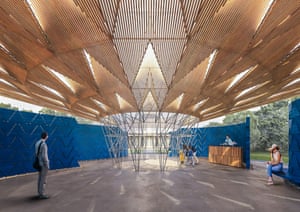
The interior of Francis Kéré’s pavilion. Photograph: Serpentine gallery
“I told myself, ‘Francis, don’t try to change yourself for this commission’,” he says. “Remain true to how you started, but do a little bit more. Here I have the chance to work with amazing engineers, so we can make the steel very thin and have an impressive cantilever.”
Kéré was born in 1965 in the village of Gando, a place with no running water or electricity, 125 miles southeast of the capital of Ouagadougou, making him unique as an architect who now moves in the glamorous circles of international biennales and professorships at Harvard. His face is still ringed with tribal scars in a pattern of spokes, marking him out as the son (and sun) of the village chief, a position of privilege that gave him the rare chance to attend high school in the city. At 18, he won a scholarship to study woodwork in Germany, but, realising there was not much use for carpentry in a country that has little wood, he switched to study architecture at the Technical University of Berlin.
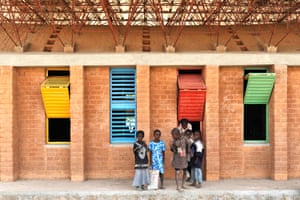
Gando school extension, developed out of Kéré’s final year university project.
Photograph: Erik-Jan Ouwerkerk
In his final year he designed a primary school for Gando and used his ample charisma and energy to raise enough money to see it built. The project was the first test of what would become his characteristic style of rural hi-tech: a pair of simple rectangular volumes made of mud bricks, crowned with a “flying roof” of vaulted corrugated metal. It won the Aga Khan award for architecture in 2004 and has since been expanded with a library, secondary school, teachers’ housing and a community centre.
Kéré was invited to become an emissary for the award, scouring the continent for other exemplar projects, but he had misgivings. “I stopped because everywhere I went they said, ‘Give us the tools to make good architecture before coming to ask for good architecture,’” he said in an interview. As a result, his motto is “help to self-help” – his projects place more importance on the process of local capacity-building than the finesse of the final product.
It is a collaborative, user-driven mode of practice that makes him an interesting choice for the Serpentine commission, which is essentially a hastily built stage set for hosting summer parties, usually then sold on to a collector. Might Kéré be employing local apprentice builders and trying to extend the impact of the project beyond being a diverting decoration for the lawn? “It would have been great, but it’s not easy working in this context,” he says. “The participation will happen when people come to take ownership of the structure, but I am working with partners to see if it can travel, and maybe end up in Africa as a museum or library.”
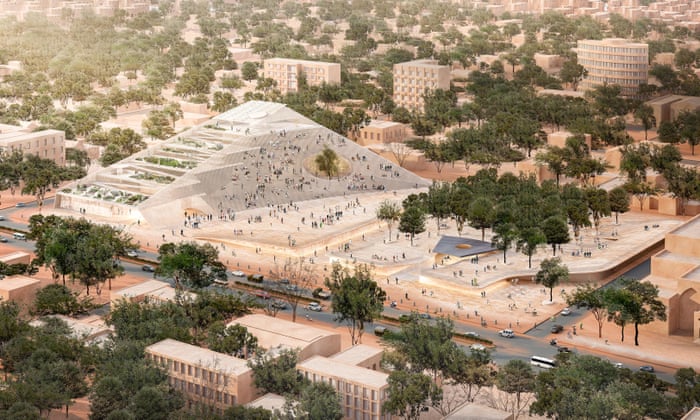 |
| Kéré’s proposed Burkina Faso National Assembly and Memorial park. Photograph: Kéré architecture |
Based in Berlin, where he runs a practice of 12 people, Kéré now uses commissions in Europe to subsidise the work back home, much of which is low-paid or pro bono. With one hand he designs boutique stores for shoe brand Camper and works on commercial masterplans in Germany; with the other he continues to build schools, health centres and libraries in India, Mali and Yemen, as well as an educational campus in Kenya, in the village where Barack Obama’s father was born. One of his most ambitious ongoing projects is the construction of an “opera village” in Laongo, near Ouagadougou, a world-class performance venue initiated by the late German theatre director Christoph Schlingensief, for which a school, clinic, art studios and a dozen homes have so far been built.
The Serpentine commission is just the latest in a series of international accolades Kéré has enjoyed over the past few years. As one of the few African architects with a global profile, he is continually courted by conferences and exhibitions around the world. He took part in the Royal Academy’s Sensing Spaces exhibition in 2014 (where he made a participatory tunnel of colourful straws), the Chicago Biennial in 2015, and the Venice Biennale last year, where he presented what could become the project of his lifetime, a new national parliament building for Burkina Faso.
“Most of the population has never seen higher than the height of a tree,” he says, describing his plan for a mountain-like building of staggered terraces, where people would be able to sit and enjoy views of the city. After the country’s 2014 uprisings, when the parliament was torched and the president was hounded out of the country after a 27-year reign, Kéré says there is an urgent need for openness and transparency. “The people will be able to climb above the politicians – what could be more symbolic?”










